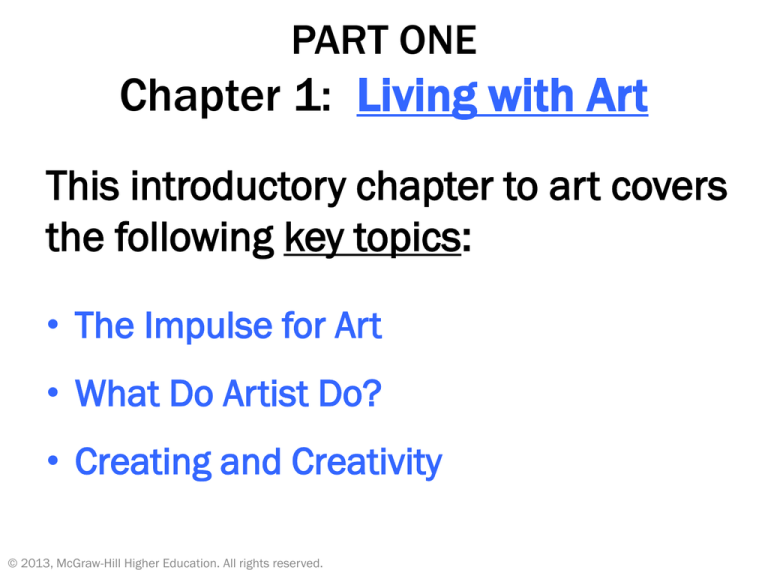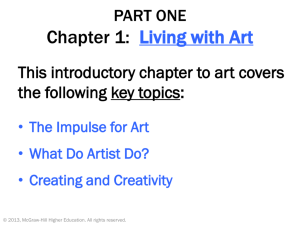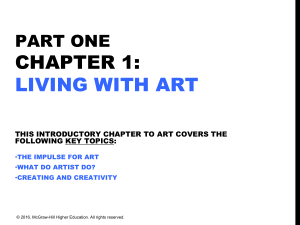
PART ONE
Chapter 1: Living with Art
This introductory chapter to art covers
the following key topics:
• The Impulse for Art
• What Do Artist Do?
• Creating and Creativity
© 2013, McGraw-Hill Higher Education. All rights reserved.
Studio Space,
Brancusi
Bird In Space, Brancusi
What does Brancusi mean?
• “They are imbeciles who call my work
abstract. That which they call abstract
is the most realistic, because what is
real is not the exterior but the idea, the
essence of things.”
― Constantin Brancusi
Key terms for this chapter include:
• aesthetics
• megaliths
• Neolithic
• selective perception
• vanitas
© 2013, McGraw-Hill Higher Education. All rights reserved.
Aesthetics:
Branch of philosophy that deals with
feelings aroused by the sensory
experiences of sight, hearing, taste,
touch, and smell. Our responses to the
natural world and questions such as
“What is art?” are issues of aesthetics.
© 2013, McGraw-Hill Higher Education. All rights reserved.
The Impulse for Art
• What we know of human history
indicates that no society has lived
without some form of art.
• The ability to make images is uniquely
human and it is the starting point for
creating art.
© 2013, McGraw-Hill Higher Education. All rights reserved.
LION PANEL, CHAUVET CAVE
The Impulse for Art
To construct meaningful images and
forms, to create order and structure, to
explore aesthetic possibilities are
characteristics that seem to be part of
our nature as human beings.
• Neolithic: New Stone Age
• Megaliths: Large stones
© 2013, McGraw-Hill Higher Education. All rights reserved.
What Do Artists Do?
Artists fulfill many roles within society:
•To create places for some human purpose
•To create extra-ordinary versions of ordinary objects
•To record and commemorate
•To give tangible form to the unknown
•To give tangible form to feelings and ideas
•To refresh our vision and see the world in a new way
© 2013, McGraw-Hill Higher Education. All rights reserved.
Stonehenge, 3000-2000BC
Purpose – community rituals
Vietnam Veterans Memorial,
Maya Lin
Purpose - contemplation and remembrance
Kente cloth, Ghana
Purpose – create extraordinary version of
ordinary objects
Jahangir Receives a Cup from
Khusrau, Manohar 1605-06
Purpose – Record and commemorate
Shiva Nataraja, India
Purpose – Give tangible form
to unknown
Starry Night , Vincent Van
Gogh
Purpose – Give tangible form to feelings
http://www.youtube.com/watch?v=dipFMJck
ZOM
We take death to reach a star.
"This morning I saw the country from my window a long time before
sunrise, with nothing but the morning star, which looked very big,"
van Gogh wrote to his brother Theo, from France. Rooted in
imagination and memory, The Starry Night embodies an inner,
subjective expression of van Gogh’s response to nature. In thick,
sweeping brushstrokes, a flame-like cypress unites the churning sky
and the quiet village below. The village was partly invented, and the
church spire evokes van Gogh's native land, the Netherlands.
Peeling Paint on Iron Bench, Ernst Haas, Kyoto, 1981
Purpose – Refresh our visions and help see world in different ways
Creating & Creativity
Artists are devoted to visual creativity. Creative
people, in general, tend to possess certain
traits:
1. Sensitivity: heightened awareness
2. Flexibility: adapt to new possibilities
3. Originality: creatively problem-solve
4. Playfulness: humor & experimentation
5. Productivity: ability to generate ideas
6. Fluency: free flow of ideas
7. Analytical skill: exploring problems
8. Organizational skill: coherently ordering things
© 2013, McGraw-Hill Higher Education. All rights reserved.
Kandors Full Set, Mike Kelley, 2005-2009
Cast resin, blown glass
• Kandor is the place
where Superman was
born. Before Krypton
was destroyed, Kandor
was miniaturized and
kept under a glass bell
jar in the Fortress of
Solitude. Created for
turn of millenium.
Looking and Responding
The key to looking at art is to become
aware of the process of looking.
• Selective Perception: Filtering information
to allow us to focus on the immediate
tasks at hand.
• Vanitas: (Latin for “vanity”) Refers to the
fleeting nature of earthly life and
happiness.
© 2013, McGraw-Hill Higher Education. All rights reserved.
http://www.moillusions.com/category/spot-the-object-optical-illusions
EVERY TOUCH, Jim Hodges
Vanitas is a type of symbolic
work of art associated with still
life painting in Flanders and the
Netherlands in the 16th and
17th centuries. The Latin word
means "vanity" and loosely
translated corresponds to the
meaninglessness of earthly life
and the transient nature of all
earthly goods and pursuits.
http://rise-worldwide.co.nz/2011/09/vanitas-artwork/
Vanitas
By Juan de Valdés Leal
Wheel of Fortune (Vanitas)
By Audrey Flack
Your project:
-No smaller than 11x14
-Collage, photograph, &/or drawing
-No white paper showing
-Relates to you
-Relates to our time
Your presentation:
-Voice projection
-Explanation
-Eye contact
Living with Art: Summary
Works of art can have many meanings.
The greatest works of art can transcend
time to speak to each new generation.
Key Topics
Key Terms
• The Impulse for Art • aesthetics
• What Do Artist Do? • megaliths
• Creating and
Creativity
© 2013, McGraw-Hill Higher Education. All rights reserved.
• Neolithic
• selective perception
• vanitas












